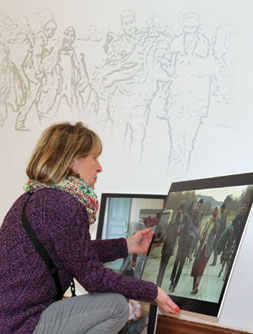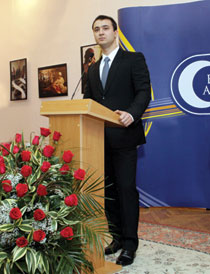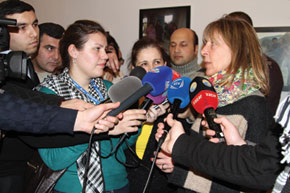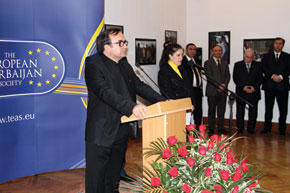 Frederique Lengaigne is now a documentary film-maker, but in 1992 she was working for the Reuters agency in Moscow, photographing the collapse of the Soviet Union. With the outbreak of fighting in Nagorno-Karabakh she travelled to Azerbaijan and was in Aghdam at the end of February. She witnessed and recorded the influx of bodies and refugees from the town of Khojaly, following the bloodiest night of the war, after which 613 men, women, children and babies lay dead and the fates of 150 others are still unknown.
Frederique Lengaigne is now a documentary film-maker, but in 1992 she was working for the Reuters agency in Moscow, photographing the collapse of the Soviet Union. With the outbreak of fighting in Nagorno-Karabakh she travelled to Azerbaijan and was in Aghdam at the end of February. She witnessed and recorded the influx of bodies and refugees from the town of Khojaly, following the bloodiest night of the war, after which 613 men, women, children and babies lay dead and the fates of 150 others are still unknown.In commemoration of the 20th anniversary of that massacre, The European Azerbaijan Society (TEAS) organised an exhibition in Baku’s Museum Centre of sixty-five of Frederique’s photographs and invited the photographer herself to Azerbaijan to share her impressions and memories.
Opening the exhibition on 20 February, TEAS Chairman Tale Heydarov declared that while the intention that night had been to inflict a crushing blow on Azerbaijan and its people, the ensuing 20 years had proved that their spirit was unbroken and they were making renewed efforts to raise awareness of the events of that night and to regain control of the Azerbaijani lands still under occupation. He expressed his appreciation of Mme Lengaigne’s contribution in providing the international community with valuable archive evidence.
Part of your history
Frederique Lengaigne spoke very humanely of the guilt she and other journalists had felt as they were taking the photographs: should she be doing that or should she be doing something else to help? However,
The pictures showed the rest of the world what happened. 20 years later, the pictures come back…. I am relieved of guilt. The pictures are part of your history. It was right to take those pictures; they are true pictures of people.
Father Patrick Desbois, President of Yahad-In Unum, explained his mission to locate the graves of Jews, gypsies and others killed in Eastern Europe in World War II. He was in Azerbaijan because many Jewish people had survived by finding refuge in the country. He was proud that Azerbaijan, too, identified and showed pictures of the victims of Khojaly;
They were all human beings…. One cannot remain silent about this tragedy. This exhibition will help to remind people that we cannot build a world on crime.
The pictures themselves, some being shown publicly for the first time, were just some of more than 300 taken over 3 days in that Aghdam winter. There were terrible scenes of battered, mutilated and bullet-riddled bodies, including those of very young children. Surgeons struggling to operate on the influx of injured in the bloodied gloom of a makeshift hospital in a railway carriage. Perhaps the most affecting were those of horrified and exhausted survivors, some shoeless, some being carried, stumbling along the road to escape scenes that would haunt them for the rest of their lives.
A particularly poignant moment at the opening event occurred when Frederique Lengaigne met Shamil Alekberli – the first time they had seen each other since she took his picture assisting survivors to complete their trek to Aghdam twenty years before. Shamil was a soldier then, but the experience has stayed with him and he now runs an NGO, the Khojali Genocide Recognition Centre.
We will never forget
Visions had a brief word with Father Desbois after his speech on the impact of the exhibition. He commented:
This exhibition is very important. You can see here many faces of dead women, children, adults and old people. All these pictures will be kept forever by the photograph. I think it is very important for the future of humanity that now we state stop the crimes [against] civilian people and we will never forget these ladies, these children, and the names of the families.
And on the connection between Khojaly and his work on the Holocaust:
It’s all victims. Everybody has been killed for nothing. The tendency of modernity is to forget the victims and to build the world …. We don’t want to forget. Even [that one] small child was killed in this village [Khojali] is important and we will never forget.
The following day, Frederique Lengaigne took some time to reflect with us on what she saw in Aghdam and on the exhibition of her photographs:
Could you give us your impressions of what you saw in Aghdam?
Well, we all arrived a few days after the massacre…. we didn’t know what we were going to find…. if I remember correctly I thought there was just an increase in the fighting in the region…. [in Aghdam] there was an atmosphere, panic is not exactly the right term, there was a form of hysteria. People were talking too loud, people were walking too fast; it was very busy….
Some of your pictures were taken in a mosque where the bodies of people killed were taken, what was it like there?
First of all I didn’t know if I would be able to take pictures there, I was a bit unconfident…. but the people wanted me to take pictures and it was surprising for me being in a mosque…. photographing men…. as a woman. But people had other things on their mind, obviously. I can see in the pictures that there must have been a lot of crying, from women especially, but no matter how I try I remember it as silent, I cannot remember the noise. I thought it was actually quite silent, even though women must have cried and screamed. I think there were long periods of silence…. At the end of the day people were coming to see; they could not believe their eyes. They must have heard the news in the street…. They were looking, just looking…. Many of the people didn’t have any relatives there, but they were very silent, silent.
Other pictures were taken in a railway carriage; a kind of field hospital had been set up. How were the doctors coping?
I don’t know when this hospital train had been set up, but it looked like it had been there for a while. I took pictures there but for me that was very…. you know taking pictures of dead people is one thing, but taking pictures of wounded people, in pain, that’s almost unbearable. You feel like you are doing something wrong….They were very organised, it was not at all messy or in panic. The hospital people were very organised.
This was a particularly shocking part of the war, over 600 people were killed in one night, and you pictures show the horror and terror of that night. Do you think this had a big impact on the world generally?
There were a lot of stories in the former Soviet Union at that time, there had been Georgia; and later there would be Afghanistan. Basically, in ‘89, ‘90 and ’91 people had followed all the wars or civil wars in the republics or inside the former Soviet Union, but in that case, in Aghdam, I believe people outside had no idea: What was it? Where was it? The Nagorno-Karabakh conflict was very unclear for people…. I believe it was a problem for the media to tell those stories…. I think the media were interested in the story…. they were interested to know if Russia was going to intervene, not only here, but in other parts of the Caucasus.
Your photographs made a strong impression at last night’s commemoration exhibition. What were your feelings as you looked back?
Two feelings; one feeling of discovering again. That’s the wonder of photography. It feeds the memory; you think that you have forgotten, but it pumps back from the pictures…. But it’s 20 years ago, that’s a lot of time, it’s really a generation….
You met last night one of the men [Shamil Alekberli - ed] who is in some of the photographs. Did that bring back memories?
I did remember especially that man. I have always remembered him. I remember him at the scene. We waited on that road for quite a long time, and he was there. I was very happy to see him; I was very happy to see somebody alive from those pictures.
Last night you talked about guilt at the time. But now your feelings are slightly different.
Every photographer feels like that when you are taking those kinds of pictures; if you don’t, you have a problem; you should ask yourself questions as a photographer. But when time passes and the pictures effectively become part of history, then their role, their value, becomes evident and you feel innocent.
One reason for the exhibition was to seek an assessment of that event. No one has been brought to justice for what happened then. Do you have a view on that?
It is so difficult for individuals…. it is too difficult for individuals to forgive and forget, but for states it’s possible….that is one of the best roles of a state, to be able to do that for its people.
Talking about states the UN Security Council passed four resolutions in 1993 demanding that the occupying forces leave Azerbaijan. They are still there – why do you think the survivors of that dreadful night are still waiting to go home?
I have no answer for that; I have no answer for the reason that wars are stupid anyway and the results of them are illogical.
Obviously interesting for people of Azerbaijan why those resolutions are not acted on, while resolutions like last year’s on Libya are acted on immediately.
Of course, and my feelings, I’m sure, are nothing compared to people from Azerbaijan’s feelings, but I do wish Azerbaijan and Armenia to come to some peaceful terms and that is all that is in my mind. I know that for the people it is important to get justice, but all that is important is to be two neighbours, to find terms of peace. It’s unfortunate sometimes that the UN …. doesn’t really help, but there is no other way round; Azerbaijan and Armenia have to make some kind of peace – and quickly, I mean this is 20 years….
And how do you feel about your photographs now?
I do feel now they are part of history. It doesn’t really matter if they are good pictures or bad ones. The goal was not to make beautiful pictures, so they are what they are; they are part of history. That’s all they are.
Do you get hope from any of those pictures?
No. But on the last day some soldiers took us around and it was a beautiful day…. we didn’t take any pictures…. the countryside was so beautiful.
This is what the Khojaly survivors remember about their homeland. Thank you very much for your contribution to their history.





